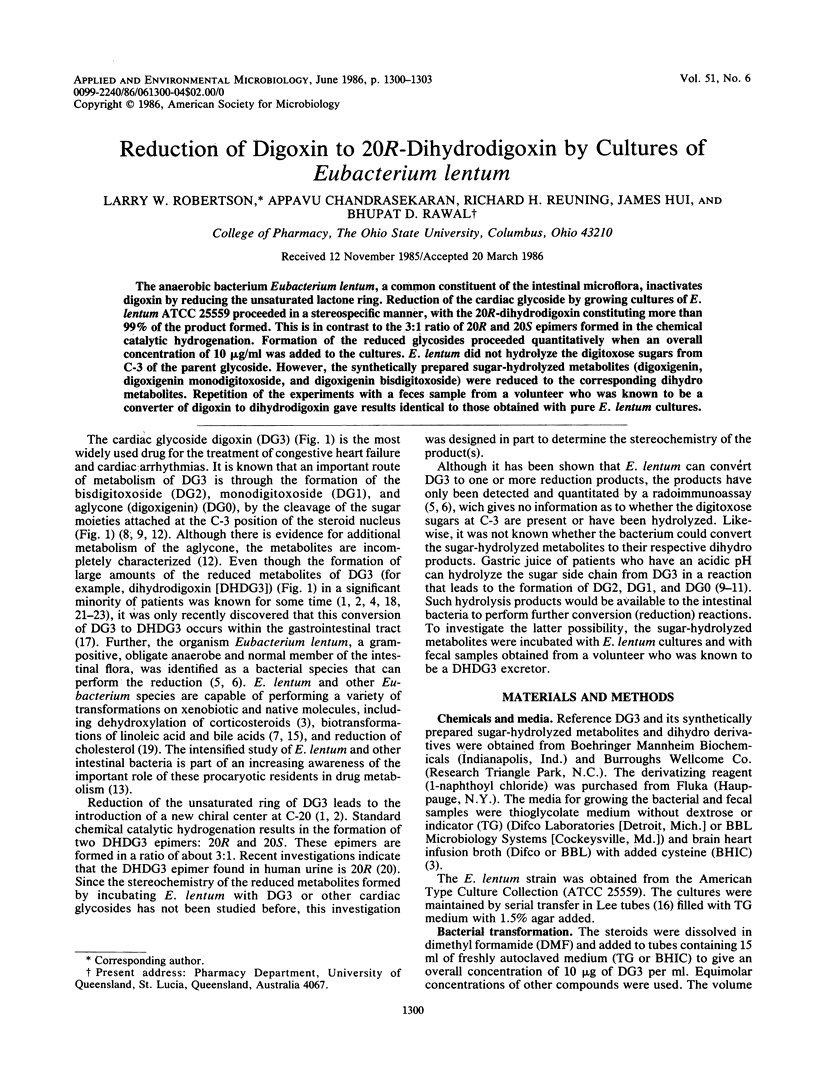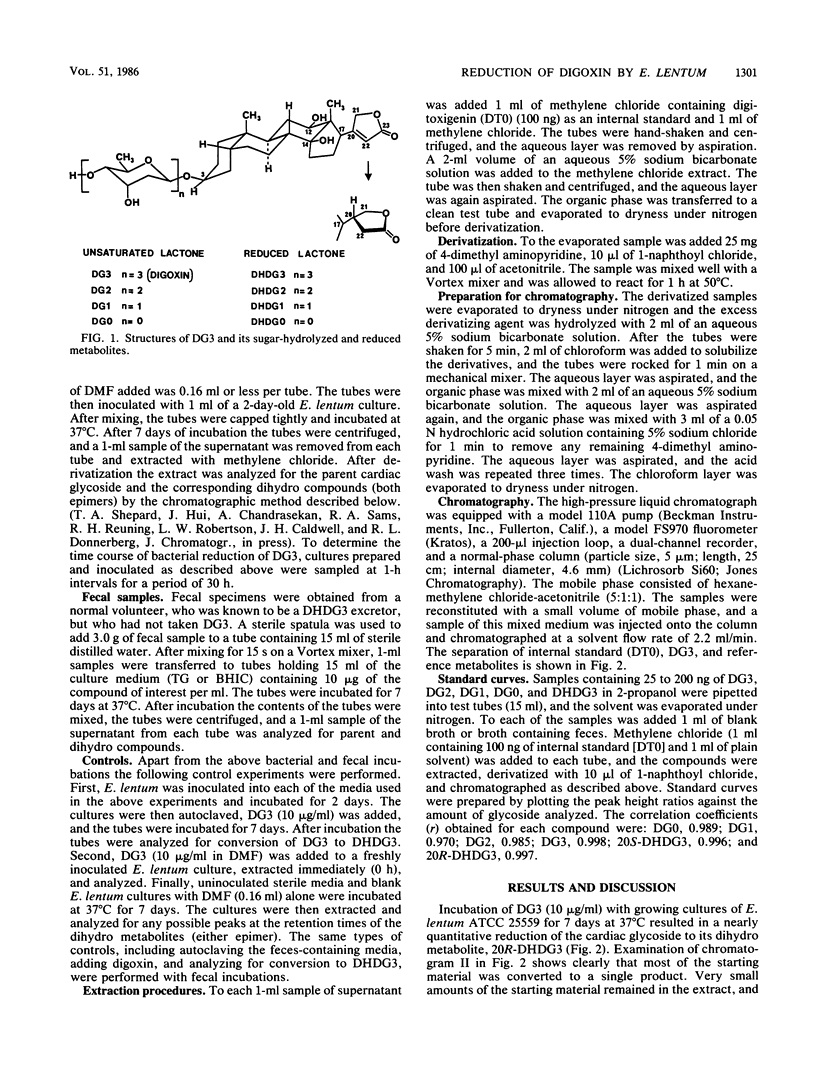Abstract
The anaerobic bacterium Eubacterium lentum, a common constituent of the intestinal microflora, inactivates digoxin by reducing the unsaturated lactone ring. Reduction of the cardiac glycoside by growing cultures of E. lentum ATCC 25559 proceeded in a stereospecific manner, with the 20R-dihydrodigoxin constituting more than 99% of the product formed. This is in contrast to the 3:1 ratio of 20R and 20S epimers formed in the chemical catalytic hydrogenation. Formation of the reduced glycosides proceeded quantitatively when an overall concentration of 10 micrograms/ml was added to the cultures. E. lentum did not hydrolyze the digitoxose sugars from C-3 of the parent glycoside. However, the synthetically prepared sugar-hydrolyzed metabolites (digoxigenin, digoxigenin monodigitoxoside, and digoxigenin bisdigitoxoside) were reduced to the corresponding dihydro metabolites. Repetition of the experiments with a feces sample from a volunteer who was known to be a converter of digoxin to dihydrodigoxin gave results identical to those obtained with pure E. lentum cultures.
Full text
PDF



Selected References
These references are in PubMed. This may not be the complete list of references from this article.
- Bockbrader H. N., Reuning R. H. Digoxin and metabolites in urine: a derivatization--high-performance liquid chromatographic method capable of quantitating individual epimers of dihydrodigoxin. J Chromatogr. 1984 Sep 14;310(1):85–95. doi: 10.1016/0378-4347(84)80070-5. [DOI] [PubMed] [Google Scholar]
- Bockbrader H. N., Reuning R. H. Spectral analysis of the configuration and solution conformation of dihydrodigoxigenin epimers. J Pharm Sci. 1983 Mar;72(3):271–274. doi: 10.1002/jps.2600720315. [DOI] [PubMed] [Google Scholar]
- Bokkenheuser V. D., Winter J., O'Rourke S., Ritchie A. E. Isolation and characterization of fecal bacteria capable of 16 alpha-dehydroxylating corticoids. Appl Environ Microbiol. 1980 Oct;40(4):803–808. doi: 10.1128/aem.40.4.803-808.1980. [DOI] [PMC free article] [PubMed] [Google Scholar]
- Clark D. R., Kalman S. M. Dihydrodigoxin: a common metabolite of digoxin in man. Drug Metab Dispos. 1974 Mar-Apr;2(2):148–150. [PubMed] [Google Scholar]
- Dobkin J. F., Saha J. R., Butler V. P., Jr, Neu H. C., Lindenbaum J. Inactivation of digoxin by Eubacterium lentum, an anaerobe of the human gut flora. Trans Assoc Am Physicians. 1982;95:22–29. [PubMed] [Google Scholar]
- Eyssen H., Verhulst A. Biotransformation of linoleic acid and bile acids by Eubacterium lentum. Appl Environ Microbiol. 1984 Jan;47(1):39–43. doi: 10.1128/aem.47.1.39-43.1984. [DOI] [PMC free article] [PubMed] [Google Scholar]
- Gault H., Kalra J., Ahmed M., Kepkay D., Barrowman J. Influence of gastric pH on digoxin biotransformation. I. Intragastric hydrolysis. Clin Pharmacol Ther. 1980 Jan;27(1):16–21. doi: 10.1038/clpt.1980.3. [DOI] [PubMed] [Google Scholar]
- Gault H., Kalra J., Ahmed M., Kepkay D., Longerich L., Barrowman J. Influence of gastric pH on digoxin biotransformation. II. Extractable urinary metabolites. Clin Pharmacol Ther. 1981 Feb;29(2):181–190. doi: 10.1038/clpt.1981.29. [DOI] [PubMed] [Google Scholar]
- Gault H., Kalra J., Longerich L., Dawe M. Digoxigenin biotransformation. Clin Pharmacol Ther. 1982 Jun;31(6):695–704. doi: 10.1038/clpt.1982.98. [DOI] [PubMed] [Google Scholar]
- Gault M. H., Charles J. D., Sugden D. L., Kepkay D. C. Hydrolysis of digoxin by acid. J Pharm Pharmacol. 1977 Jan;29(1):27–32. doi: 10.1111/j.2042-7158.1977.tb11232.x. [DOI] [PubMed] [Google Scholar]
- Heinz N., Flasch H. Comparison of the pharmacokinetics of digoxin and dihydrodigoxin in cats in single-dose studies. Naunyn Schmiedebergs Arch Pharmacol. 1978 Jun;303(2):181–187. doi: 10.1007/BF00508066. [DOI] [PubMed] [Google Scholar]
- Hirano S., Masuda N. Transformation of bile acids by Eubacterium lentum. Appl Environ Microbiol. 1981 Nov;42(5):912–915. doi: 10.1128/aem.42.5.912-915.1981. [DOI] [PMC free article] [PubMed] [Google Scholar]
- Lee S. Y., Moore S. E., Mabee M. S. Selective-differential medium for isolation and differentiation of pectinatus from other brewery microorganisms. Appl Environ Microbiol. 1981 Feb;41(2):386–387. doi: 10.1128/aem.41.2.386-387.1981. [DOI] [PMC free article] [PubMed] [Google Scholar]
- Lindenbaum J., Rund D. G., Butler V. P., Jr, Tse-Eng D., Saha J. R. Inactivation of digoxin by the gut flora: reversal by antibiotic therapy. N Engl J Med. 1981 Oct 1;305(14):789–794. doi: 10.1056/NEJM198110013051403. [DOI] [PubMed] [Google Scholar]
- Lindenbaum J., Tse-Eng D., Butler V. P., Jr, Rund D. G. Urinary excretion of reduced metabolites of digoxin. Am J Med. 1981 Jul;71(1):67–74. doi: 10.1016/0002-9343(81)90260-6. [DOI] [PubMed] [Google Scholar]
- Mott G. E., Brinkley A. W., Mersinger C. L. Biochemical characterization of cholesterol-reducing Eubacterium. Appl Environ Microbiol. 1980 Dec;40(6):1017–1022. doi: 10.1128/aem.40.6.1017-1022.1980. [DOI] [PMC free article] [PubMed] [Google Scholar]
- Reuning R. H., Shepard T. A., Morrison B. E., Bockbrader H. N. Formation of [20R]-dihydrodigoxin from digoxin in humans. Drug Metab Dispos. 1985 Jan-Feb;13(1):51–57. [PubMed] [Google Scholar]
- Rund D. G., Lindenbaum J., Dobkin J. F., Butler V. P., Jr, Saha J. R. Decreased digoxin cardioinactive-reduced metabolites after administration as an encapsulated liquid concentrate. Clin Pharmacol Ther. 1983 Dec;34(6):738–743. doi: 10.1038/clpt.1983.243. [DOI] [PubMed] [Google Scholar]
- Saha J. R., Butler V. P., Jr, Neu H. C., Lindenbaum J. Digoxin-inactivating bacteria: identification in human gut flora. Science. 1983 Apr 15;220(4594):325–327. doi: 10.1126/science.6836275. [DOI] [PubMed] [Google Scholar]
- Sugden D., Ahmed M., Gault M. H. Fractionation of tritiated digoxin and dihydrodigoxin with DEAE-sephadex LH-20. J Chromatogr. 1976 Jun 23;121(2):401–404. doi: 10.1016/s0021-9673(00)85041-4. [DOI] [PubMed] [Google Scholar]
- Watson E., Clark D. R., Kalman S. M. Identification by gas chromatography-mass spectroscopy of dihydrodigoxin--a metabolite of digoxin in man. J Pharmacol Exp Ther. 1973 Feb;184(2):424–431. [PubMed] [Google Scholar]


